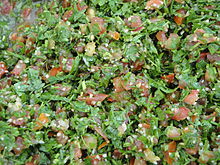This is an old revision of this page, as edited by 181.105.100.37 (talk) at 22:40, 29 December 2017 (Undid revision 817608527 by 108.73.189.247 (talk) nice try). The present address (URL) is a permanent link to this revision, which may differ significantly from the current revision.
Revision as of 22:40, 29 December 2017 by 181.105.100.37 (talk) (Undid revision 817608527 by 108.73.189.247 (talk) nice try)(diff) ← Previous revision | Latest revision (diff) | Newer revision → (diff) Tabbouleh Tabbouleh | |
| Course | Salad |
|---|---|
| Place of origin | Levant |
| Region or state | Caucasus (Armenia, Azerbaijan, Chechnya, and Georgia), Southern Europe (Cyprus and Greece), the Middle East (Iraq, Israel, Jordan, Lebanon, Palestine, Syria, and Turkey) |
| Serving temperature | Cold |
| Main ingredients | Parsley, tomato, bulgur |
| Variations | Pomegranate seeds instead of tomato |
Tabbouleh (Template:Lang-ar taboūleh; also tabouleh or tab(b)ouli) is a Levantine vegetarian dish (sometimes considered a salad) made of tomatoes, finely chopped parsley, mint, bulgur, and onion, and seasoned with olive oil, lemon juice, and salt. Some variations add garlic or lettuce, or use couscous instead of bulgur.
Tabbouleh is traditionally served as part of a mezze in the Arab world. Variations of it are made by Armenians, Israelis, and Turks. Its popularity has grown in Western cultures.
Etymology
The Levantine Arabic tabbūle is derived from the Arabic word tābil, meaning "seasoning" or more literally "dip". Use of the word in English first appeared in the 1950s.
History
Edible herbs known as qaḍb formed an essential part of the Arab diet in the Middle Ages. Dishes like tabbouleh attest to their continued popularity in Middle Eastern cuisine today. Originally from the mountains of Lebanon and Syria, tabbouleh has become one of the most popular salads in the Middle East. The wheat variety salamouni cultivated in the region around Mount Lebanon, Beqaa Valley and Baalbek was considered (in the mid-19th century) as particularly well-suited for making bulgur, a basic ingredient of tabbouleh.
Tabbouleh and other vegetable-based mezze dishes popular in Syria were mocked by Baghdadi women and cooks when they were first introduced to them, because they were seen as being a means to scrimp on the use of meat.
Regional variations
In the Middle East, particularly Syria, in addition to Lebanon, Palestine, Israel, Jordan, and Iraq, it is usually served as part of a meze. The Lebanese use more parsley than bulgur wheat in their dish. A Turkish variation of the dish is known as kısır, while a similar Armenian dish is known as eetch. In Cyprus, where the dish was introduced by the Syrians, it is known as tambouli. In the Dominican Republic, a local version introduced by Syrian and Lebanese immigrants is called Tipile.
Like hummus, baba ghanoush, pita, and other elements of Arab cuisine, tabbouleh has become a popular American food and usually has couscous as its main ingredient.
Controversy
In December 2017 after Rachael Ray presented Hummus as an "Israeli" food, James Zogby responded: "This is cultural genocide. It’s not Israeli food. It’s Arab (Lebanese, Palestinian, Syrian, Jordanian). First the Israelis take the land & ethnically cleanse it of Arabs. Now they take their food & culture & claim it’s theirs too! Shame."
See also
- Couscous
- Iraqi cuisine
- Jordanian cuisine
- Lebanese cuisine
- List of salads
- List of vegetable dishes
- Palestinian cuisine
- Syrian cuisine
References
- Sami Zubaida, "National, Communal and Global Dimensions in Middle Eastern Food Cultures" in Sami Zubaida and Richard Tapper, A Taste of Thyme: Culinary Cultures of the Middle East, London and New York, 1994 and 2000, ISBN 1-86064-603-4, p. 35, 37; Claudia Roden, A Book of Middle Eastern Food, p. 86; Anissa Helou, Oxford Companion to Food, s.v. Lebanon and Syria; Maan Z. Madina, Arabic-English Dictionary of the Modern Literary Language, 1973, s.v. تبل
- Oxford Companion to Food, s.v. tabbouleh
- ^ Zelinsky, 2001 p. 118.
- ^ Mark Morton (2004). Cupboard Love: A Dictionary of Culinary Curiosities (2nd ed.). Insomniac Press. p. 302. ISBN 978-1-894663-66-3.
- "Tabouli: Lebanese Parsley and Bulgur Salad". Arousing Appetites. Arousing Appetites.
- Wright, 2001, p. xxi.
- Madison Books, ed. (2007). 1,001 Foods to Die For. Andrews McMeel Publishing. p. 172. ISBN 978-0-7407-7043-2.
- ^ Basan, 2007, p. 180-181.
- Nabhan, 2008, pp. 77-78.
- Caplan, 1997, p. 73.
- Wright, 2001, p. 251. "In the Arab world, tabbouleh (tabbūla) is a salad usually made as part of the mazza table (p xx) especially in Syria, Lebanon and Palestine."
- https://books.google.ca/books?id=bB2cedC3ruQC&pg=PA56
- https://twitter.com/rachaelray/status/943908309622513665
- https://twitter.com/jjz1600/status/945499686881972224
- https://www.haaretz.com/us-news/1.831607
Bibliography
- Basan, Ghillie (2007). The Middle Eastern Kitchen. Hippocrene Books. ISBN 978-0-7818-1190-3.
- Caplan, Patricia (1997). Food, health, and identity (Illustrated ed.). Routledge. ISBN 978-0-415-15680-6.
- Nabhan, Gary Paul (2008). Where our food comes from: retracing Nikolay Vavilov's quest to end famine (Illustrated ed.). Island Press. ISBN 978-1-59726-399-3.
- Wright, Clifford A. (2001). Mediterranean vegetables: a cook's ABC of vegetables and their preparation in Spain, France, Italy, Greece, Turkey, the Middle East, and north Africa with more than 200 authentic recipes for the home cook (Illustrated ed.). Harvard Common Press. ISBN 978-1-55832-196-0.
- Zelinsky, Wilbur (2001). The enigma of ethnicity: another American dilemma (Illustrated ed.). University of Iowa Press. ISBN 978-0-87745-750-3.
External links
| Lebanese cuisine | |
|---|---|
| Beverages | |
| Breads | |
| Meze | |
| Cheeses | |
| Soups | |
| Dishes | |
| Grilled meats | |
| Desserts | |
| Frequent ingredients | |
| Unique instruments | |
| Related cuisines | |